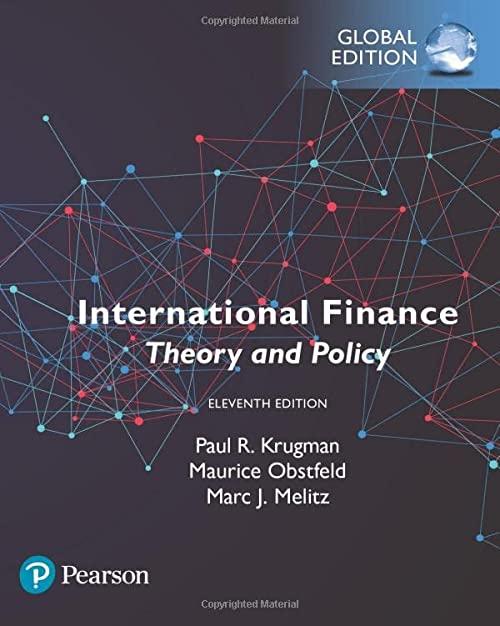Question
Q1. The estimated sales of a company is $2,000,000. ETBIT is 60% of sales. There is no depreciation and interest expense involved. The capital expenditure
Q1. The estimated sales of a company is $2,000,000. ETBIT is 60% of sales. There is no depreciation and interest expense involved. The capital expenditure is $200,000 and working capital decreased by $400,000. There is a tax rate of 20% and there are 1,000,000 shares outstanding. In this case, the Free Cash Flow to Equity per share is $ ..
Q2. The Free Cash Flow to Equity per share for next year is computed as $2. We have the following information about annual growth rate for the next five years: years 1 to 5 as 20%, 18%, 16%, 14% and 12% respectively. After year 5, the normal growth rate is 5% each year. The discount rate is 10%. Based on this data, the price of this stock as of the year 5 should be $.............. and the price of this stock as of today should be $ ..
Q 3. We know if the stock price goes up by $1.50 the value of the value of call option goes up by $.75 The stock price is currently trading for $50 and the call option has a strike price of $41. The expiration is 6 months and volatility is 10%. We do not have any other information. In this case the value of N(d1) should be closer to:
a. More than 1
b. .50
c. .75
d. Almost zero
e. We do not have enough data
Q4. A stock is trading at $40. The exercise price of its call option is $36. . The expiration is six months. The std dev is 12% The annual interest rate is 10%. There is no dividend involved. In this case, according to B&S model, the price of the call option should be $
Q5. Your client needs $100,000 each year (in dollar today) 18 years from now for a retirement period of 20 years. The rate of inflation is 4% compounded annually. He will receive $36,000 in social security each year during retirement. Ignore the rate of inflation beyond year 18 and ignore inflation for social security. How much the client needs approximately each year, adjusted for social security, during retirement. Ignore tax in this part.
a. $166,581
b. $202,581
c. Less than $165,000
d. More than $203,000
e. None of the above
Q6. Refer to Question 5. Suppose the client needs $200,000 net each year during retirement after tax. How much the client needs before tax? The income tax rate is 20%? The answer is:
a. $240,000
b. $250,000
c. Less than $240,000
d. More than $250,000
e. None of the above
Q7. Your client needs $80,000 each year (in dollar today) 15 years from now for a retirement period of 20 years. The rate of inflation is 4% for the next 15 years compounded annually. There is no social security during retirement. Ignore the rate of inflation and the rate of investment beyond year 15. There is an investment opportunity of 7% (tax exempt) compounded monthly. On a monthly basis, how much should the client deposit each month to achieve this goal. The answer is closer to:
a. Less than $9000
b. 9091
c. $11363
d. More than $11425
e. None of the above
Q8. The monthly stock prices in the month of November back to June are $80, 82, 83, 88, 90 and 92 respectively. The annualized risk/return ratio of this stock is .
Q9. The Free Cash Flow to Equity is computed as $762,000. In our computation depreciation and interest were $50,000 and $40,000 respectively. Additional working capital and capital expenditures were $50,000 and $60,000 respectively. The EBIT should be closer to:
a. $800,000
b. Less than $799,999
c. More than $800,001
d. 60% of sales
e. Cannot be computed
Q10. Refer to Q9. If the computed EBIT is 25% of sales and EBIT is $500,000 the total sales should be
a. $2,000,000
b. $3,200,000
c. More than $3,200,000
d. Less than $2,000,000
e. Cannot be computed
Q11. You bought a 15 year maturity bond with a coupon rate of 10% paid semi-annually. You will sell this bond two years from now. The reinvestment rates are 10% in year 1 and 8% in year 2 and will remain constant for the remainder of its duration. You sell this bond after two years at a price closer to:
a. At discount
b. $ 1170
c. $1159
d. Above $1170
e. None of the above
Q12. Refer to Question 11. The annualized rate of return of this investment is:
- Negative
- Between 10% to 15%
- More than 16%
- Less than 10%
- None of the above
Q13. You bought 6 contacts of a put option with the exercise price of $50 and an expiration of three months. At expiration the price of the stock goes up by 10% of the exercise price. You had paid only $2 premium per share for each share of the option. In this case, the rate of return for three months is
- ($5-$2)/$2
- 1.50 (which is 150%)
- Both a and b
- 50% loss
- 100% loss
Step by Step Solution
There are 3 Steps involved in it
Step: 1

Get Instant Access to Expert-Tailored Solutions
See step-by-step solutions with expert insights and AI powered tools for academic success
Step: 2

Step: 3

Ace Your Homework with AI
Get the answers you need in no time with our AI-driven, step-by-step assistance
Get Started


